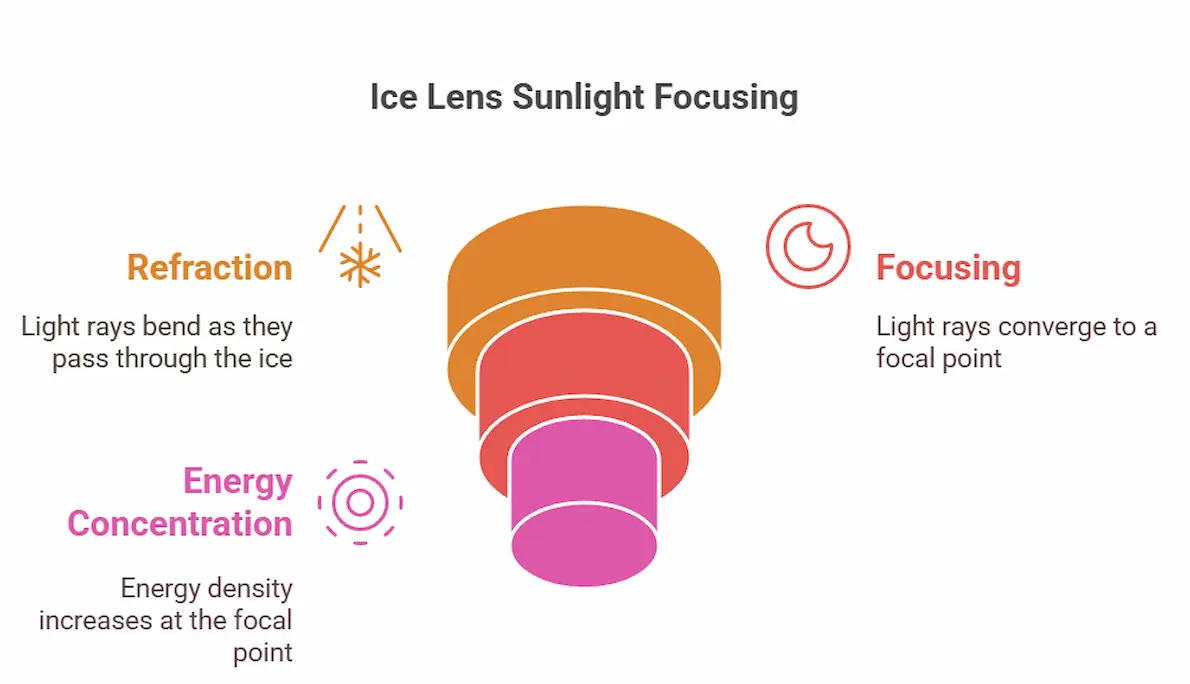Fun Facts for Survivalists: How to Start a Fire with Ice?

Is it possible to make Fire from Ice?
Yes, with specific parameters, some level of imagination, and science, one could create the phenomenon of heat and fire by juxtaposing these two elements. It sounds like something written in a fantasy book or an epic sci-fi film—fire from ice – two completely contradictory things. However, in the realm of science and imagination, almost everything is achievable.
Surviving the Cold: Fire from Ice
Here's a scenario: you find yourself by your lonesome in the Arctic tundra. The freezing weather is unbearable, and nighttime is approaching at full speed. You possess no matches and no lighter and only have a fraction of the gear you brought, as well as snow and ice. Without fire, surviving the night is impossible. As you sit there lost in thought, something flickers in your mind, a survival tip you saw once in a book: fire can be made from ice and is easier. You search for a clear piece of ice within a frozen pond and construct a convex lens using your knife. You finally get it right: a convex piece of ice. It's challenging work, but you get there in the end. You then hold it up to the sun, focusing its rays onto a thin tinder, which is dry. As expected, nothing occurs initially, but to your surprise, a wisp of smoke appears.
How can you make fire from ice?
Shaping a clear piece of ice into a convex lens allows you to start a fire using sunlight. A piece of glass burns the paper because it gelates the water and gets too hot. The best use of ice is to focus the sun's light as fire starter cams that boil water. Magnifying glasses can light on fire.
- It requires a smooth lens-shaped piece of ice, and while backfilling, it would create tinted glass.
- It needs dry, easily combustible, flammable material.
- It only works where there is intense light on the ice.
- An effective survival technology in cold regions.
- Manual and Breaking Laser Beams: Outline the basics.
Steps to do this
Find clear, bubble-free ice, carve it into a rounded lens shape thicker in the middle, smooth the surface, and use it to focus direct sunlight onto dry tinder until it smokes and catches fire.
- Find or create clear, bubble-free ice for best results.
- Shape the ice into a convex lens — thicker in the middle, thinner on the edges.
- Smooth the surface of the ice by melting or polishing to focus sunlight effectively.
- Hold the ice lens in direct sunlight and adjust the angle to concentrate light into a small bright spot.
- Use dry tinder-like bark, grass, or fine wood shavings to catch the spark quickly..
- Be patient, as the ignition can take several minutes, depending on conditions.
- Practice this technique beforehand rather than waiting for a survival situation.
- Clear ice from lakes or ponds in winter is ideal for crafting a good lens.
- Remember, this method is dependent on strong, direct sunlight.
- Keep backup methods for fire-starting when survival planning.
Why Clear Ice is Important
Cracked or cloudy ice won't just be ineffective; light and fog will scatter, and no useful concentrated heat will be created. Cleared ice brings light into focus and is the best magnifying lens.
Understand the Physics Involved in this
When ice takes the shape of a polished, smooth, and convex lens, it can refract sunlight while bending the light rays that pass through it inward. This lens effect zooms in aligned sunlight rays to a single focal point, tremendously increasing the energy density at that place. Like a magnifying glass works, the heat concentration can easily ignite dry tinder. It is most effective with intense sunlight and clear ice.

Why is this Fun fact fascinating, surprising, or relevant?
It is rather astonishing that you can start a fire using ice, mainly because it defies the norms of what fire and ice are expected to do together. Most of us assume that ice extinguishes fire and does not aid in creating fire. Using ice— solid and cold — to harness sunlight and trigger fire does the opposite of expectation. Besides that, it is also quite surprising because it showcases the human ability to adapt to extreme situations. With minimal means of resources such as ice, sunlight, and a spark of creativity, people can get past extreme conditions and situations when everything seems impossible.
Disclaimer
The concept of making fire from ice is largely a topic of scientific curiosity and exploration. While it is theoretically possible to focus sunlight through ice using its refractive properties to start a fire, this process is complex and requires specific conditions, such as clear, pure ice and intense sunlight. This phenomenon is not a simple or everyday occurrence, and attempts to replicate it should be done with caution and must not in done in home and it is important to have proper understanding of the principles involved. This article is intended for informational purposes only and does not guarantee success in achieving fire from ice under typical conditions.










